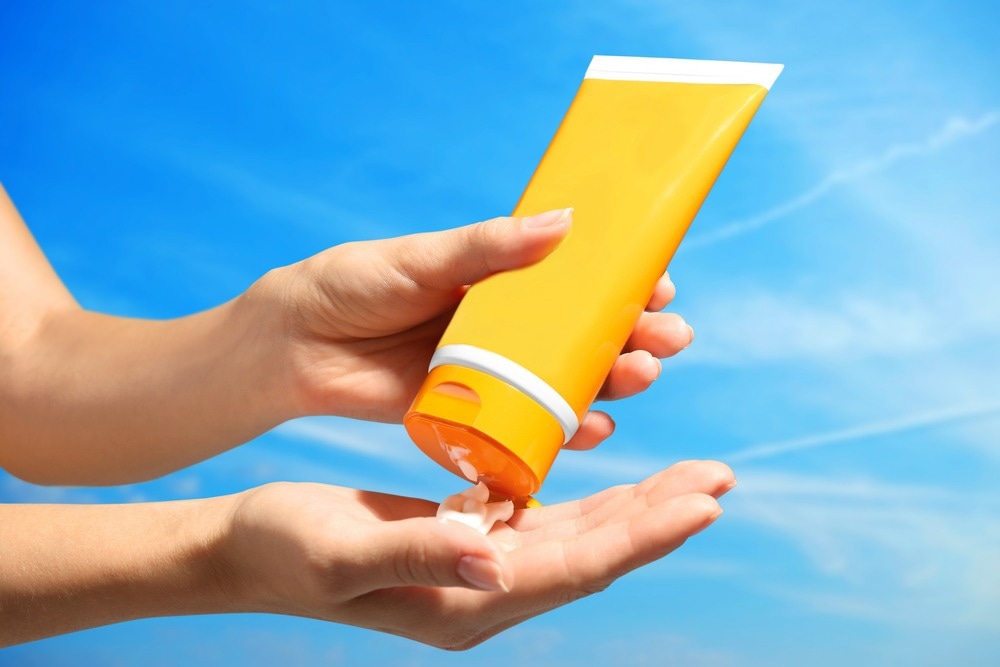Zinc oxide (ZnO) nanoparticles have recently attracted significant attention as ultraviolet (UV) scatterers because of their potential to shield human skin from UV exposure. However, the acid resistance of ZnO nanoparticles is relatively poor, leading to their decomposition on the human skin and several skin diseases.

Study: Multiple ZnO Core Nanoparticles Embedded in TiO2 Nanoparticles as Agents for Acid Resistance and UV Protection. Image Credit: Africa Studio/Shutterstock.com
A recent study published in the journal ACS Applied Nano Materials tackles this issue by fabricating novel zinc oxide/titanium dioxide (ZnO/TiO2) multi-core shell nanoparticles with remarkable acid resistance and UV protection properties.
ZnO Nanoparticles as UV Scatterers: Overview and Challenges
Increasing ozone degradation has amplified ultraviolet (UV) exposure, which is harmful to almost all living organisms. In this context, UV-protective substances are being actively developed to shield human skin from UV irradiation.
UV absorbers made of organic substances and UV scatterers made of inorganic oxide nanoparticles are the two types of UV protectants. UV scatterers, like zinc oxide (ZnO) nanoparticles, are utilized in cosmetic products that are applied directly to the human skin.
Although the UV scattering properties of ZnO nanoparticles are outstanding, their acid resistance is poor, resulting in a quick breakdown on top of the slightly acidic human skin.
This hazardous breakdown of ZnO nanoparticles owing to poor acid resistance raises numerous concerns since it has the potential to significantly harm human health. When ZnO degrades in cosmetic products like sunscreen, it produces many problems, such as decreased emulsion integrity and viscosity variations due to interactions with carboxylic acid's thickening ingredient.
Enhancing the Acid Resistance of ZnO Nanoparticles
Recently, the production of ZnO composites with other oxides has been investigated as a viable technique for improving their acid resistance. Even though silicon dioxide (SiO2) is an excellent contender for the shell layer, previous research has demonstrated that SiO2-coated ZnO composites rapidly leach away ZnO when etched with hydrochloric acid, producing hollow SiO2 nanoparticles.
As a result, it is doubtful that the SiO2 covering would increase the acid resistance of ZnO nanoparticles. To address the difficulties regarding the poor acid resistance of ZnO, a fundamental change in the synthesis method that employs other materials rather than the traditionally used SiO2 is highly desired.
In this regard, several studies have reported titanium oxide (TiO2) nanoparticles as efficient UV-absorbing substances. These nanoparticles are often employed in sunscreens to provide UV protection. Nanoscale TiO2 particles can readily absorb UV radiation because of their small size, providing a transparent barrier that protects the skin from damaging sun rays.
Additionally, the acid resistance of TiO2 nanoparticles is impressive. Consequently, ZnO/TiO2 core-shell composites can provide excellent acid resistance and UV protection.
Preparation Methods for ZnO/TiO2 Multicore-Shell Nanoparticles
Despite their great acid resistance properties, ZnO/TiO2 core-shell nanoparticles are very difficult to produce with a homogenous mixture in the liquid state.
The flame aerosol approach is the most promising approach for creating ZnO/TiO2 composites compared to standard manufacturing techniques such as the sol-gel method.
This technique can be used to create ZnO/TiO2 core-shell particles with high acid resistance by turning the core (ZnO) and shell (TiO2) materials into droplets. The TiO2 particles are then coated at the ZnO particle interface during the solvent evaporation phase.
Although the flame aerosol approach has been used to construct a single core-shell structure, no effective synthesis technique of multiple ZnO core nanoparticles encapsulated in TiO2 nanoparticles for improving acid resistance capabilities has been reported so far.
Highlights and Key Developments of the Current Study
In this study, a flame-assisted aerosol technique was used to manufacture ZnO/TiO2 multicore-shell nanoparticles effectively, and the efficiency of TiO2 nanoparticles in improving the acid resistance of zinc oxide nanoparticles was exhibited.
The titanium precursors were incorporated in the ZnO nanoparticle dispersion mixture and injected into the flame reactors, creating nanocomposites with evenly dispersed titanium and zinc molecules.
The acid resistance of ZnO/TiO2 particles was evaluated using sulfuric acid drops. The decomposition of zinc ions was minimal, showing that the acid resistance of ZnO nanoparticles was improved by incorporating a TiO2 nanoshell. The acid resistance characteristics improved by raising the concentration of TiO2 nanoparticles.
These results provide a strategy for nano-engineering ZnO/TiO2 multicore-shell particles that enhance acid resistance and may be used as a UV-protective agent in cosmetic products.
Reference
Hirano, T. et al. (2022). Multiple ZnO Core Nanoparticles Embedded in TiO2 Nanoparticles as Agents for Acid Resistance and UV Protection. ACS Applied Nano Materials. Available at: https://pubs.acs.org/doi/10.1021/acsanm.2c03489
Disclaimer: The views expressed here are those of the author expressed in their private capacity and do not necessarily represent the views of AZoM.com Limited T/A AZoNetwork the owner and operator of this website. This disclaimer forms part of the Terms and conditions of use of this website.